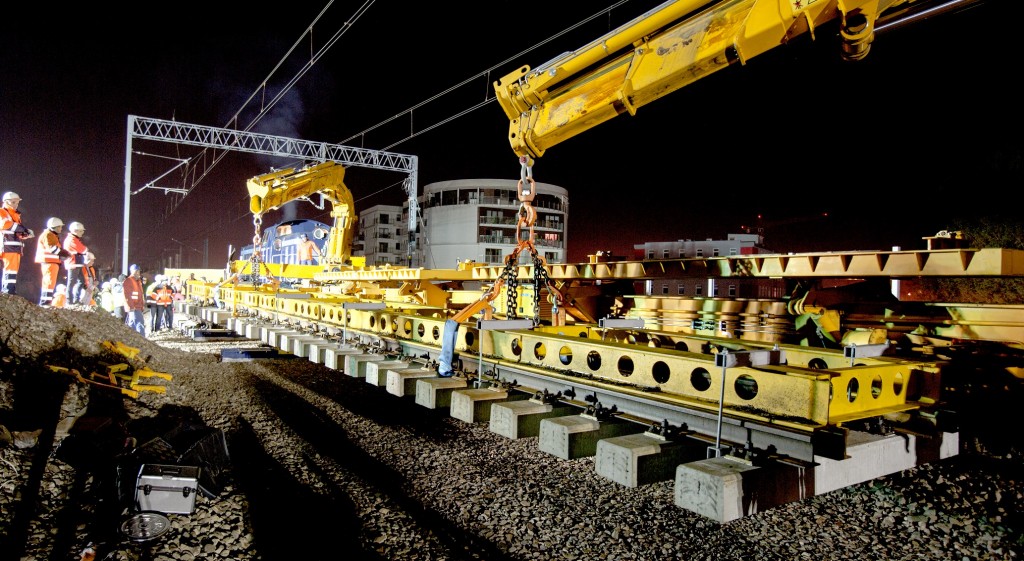Installation of a railway points system in… 275 minutes.
The Switcher transported and precisely unloaded the key railway turnout at the newly built railway link Zabłocie-Krzemionki.
The project reduced difficulties on the Kraków Główny Towarowy – Kraków Rudzice section (the so-called “średnica krakowska”), ensuring safety for passengers and track workers as well as the highest levels of railway turnout integrity for many years.
 All works were completed in less than 5 hours on the night of 6th to 7th October, when a railway turnout manufactured to the highest standards with 60E1 500 1:12 geometry at the facilities of Kolejowe Zakłady Nawierzchniowe “Bieżanów”, and assembled with pre-stressed pretensioned concrete sleepers, was delivered and installed at the site of its future use. The process was assisted by employees of KZN Rail, the exclusive operator of the innovative Switcher system. The entire process – the product, i.e. the railway switch, its advanced spanning logistics and advanced installation – was carried out within the competence and potential of the KZN Bieżanów Group.
All works were completed in less than 5 hours on the night of 6th to 7th October, when a railway turnout manufactured to the highest standards with 60E1 500 1:12 geometry at the facilities of Kolejowe Zakłady Nawierzchniowe “Bieżanów”, and assembled with pre-stressed pretensioned concrete sleepers, was delivered and installed at the site of its future use. The process was assisted by employees of KZN Rail, the exclusive operator of the innovative Switcher system. The entire process – the product, i.e. the railway switch, its advanced spanning logistics and advanced installation – was carried out within the competence and potential of the KZN Bieżanów Group.
This is yet another successful project using the help of the complex and innovative Switcher technology, which integrates transport and crane modules as well as an advanced fixing and stiffening module tailored to any type of points system. The success is all the greater because the Switcher technology debuted on the market just a few months ago.
As part of the project, KZN Rail transported and unloaded all three railway turnout sections. The switch, connecting rails and frog were delivered and put in place using the Switcher+ (HDS platform and cranes) and Switcher (long platform) wagons. Thanks to this system, which has received prizes for innovation in, among others, the Teraz Polska and Innovator Małopolski competitions, the entire process took less than five hours. The existing method of assembly, such as the few days needed during normal traffic on the critical route 91 connecting Kraków Główny and Kraków Płaszów, was an alternative solution. This section has been very busy during the construction of the Zabłocie-Krzemionki railway siding – all traffic is being directed via one rail connecting the above-mentioned stations, the other rail is undergoing reconstruction and connection to the new rail layout.
Short interview with Grzegorz Leszczyński, CEO of KZN Rail:
Why was this delivery and assembly option for the railway turnout chosen, despite the lack of such requirements on the part of the investor?
We wanted to minimize the time and difficulties during works while maximizing the initial quality of the railway switch, which will have to serve the key rail system in Krakow for many years. We significantly shortened the track closure time in addition to reducing hazards at the construction site and difficulties for the manager, carriers and passengers. We have delivered a points system to the highest standard, which will probably reduce future service, maintenance and repair work, particularly when you take into consideration that we provide a 10-year quality warranty for this project.
Is this also a way to promote the Switcher system?
Of course. We have shown that we have the technological, organizational and human potential within the company and the capital group to instantly construct and replace railway turnouts. Switcher is still a young technology and each subsequent installation provides us with further data to optimize the process. Previously, at Świdnik station, we tested how well our wagons worked with long platforms without HDS and a separate railway crane. This time we loaded and unloaded one of the railway turnouts from such a wagon using cranes located on the neighbouring Switcher+ wagons. All works were carried out in accordance with the design principles of the entire system.
Did the system pass the test?
Without a doubt. For us, as a daughter company of the railway turnout manufacturer, it was particularly important to once again confirm the reliability of the stiffening system, i.e. the “yellow grate” that follows the railway turnout from the manufacturing facilities to the assembly site accompanying its loading, transport and unloading. Due to the short distance from the construction site to the manufacturing facilities, the train additionally travelled around the Krakow railway network in order to reliably check the strength of this module. These several dozen kilometres confirmed the effectiveness of the solution – we did not notice any deflection and deformation of the structure, which would certainly occur with less advanced and less solid protection.
Other News


